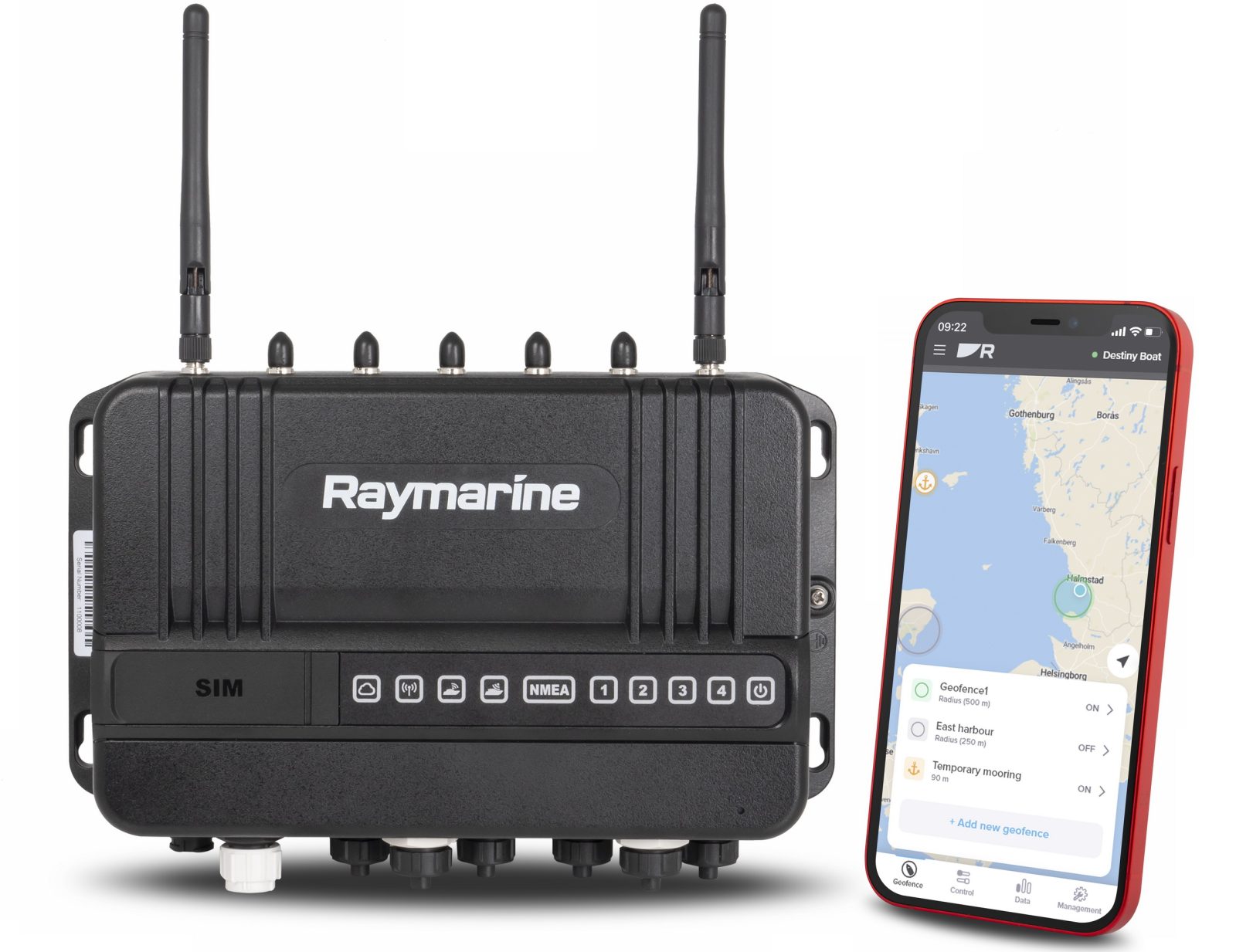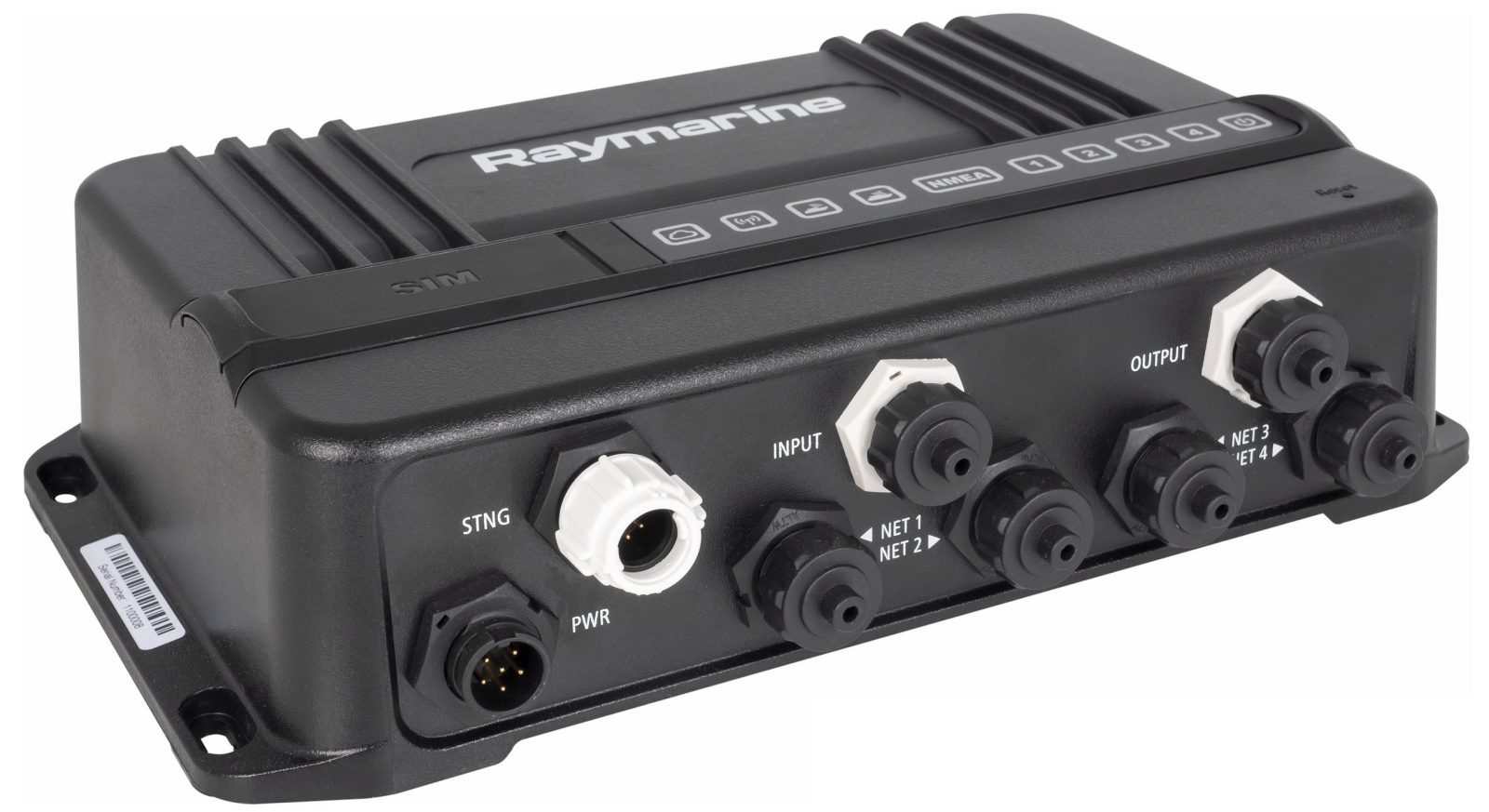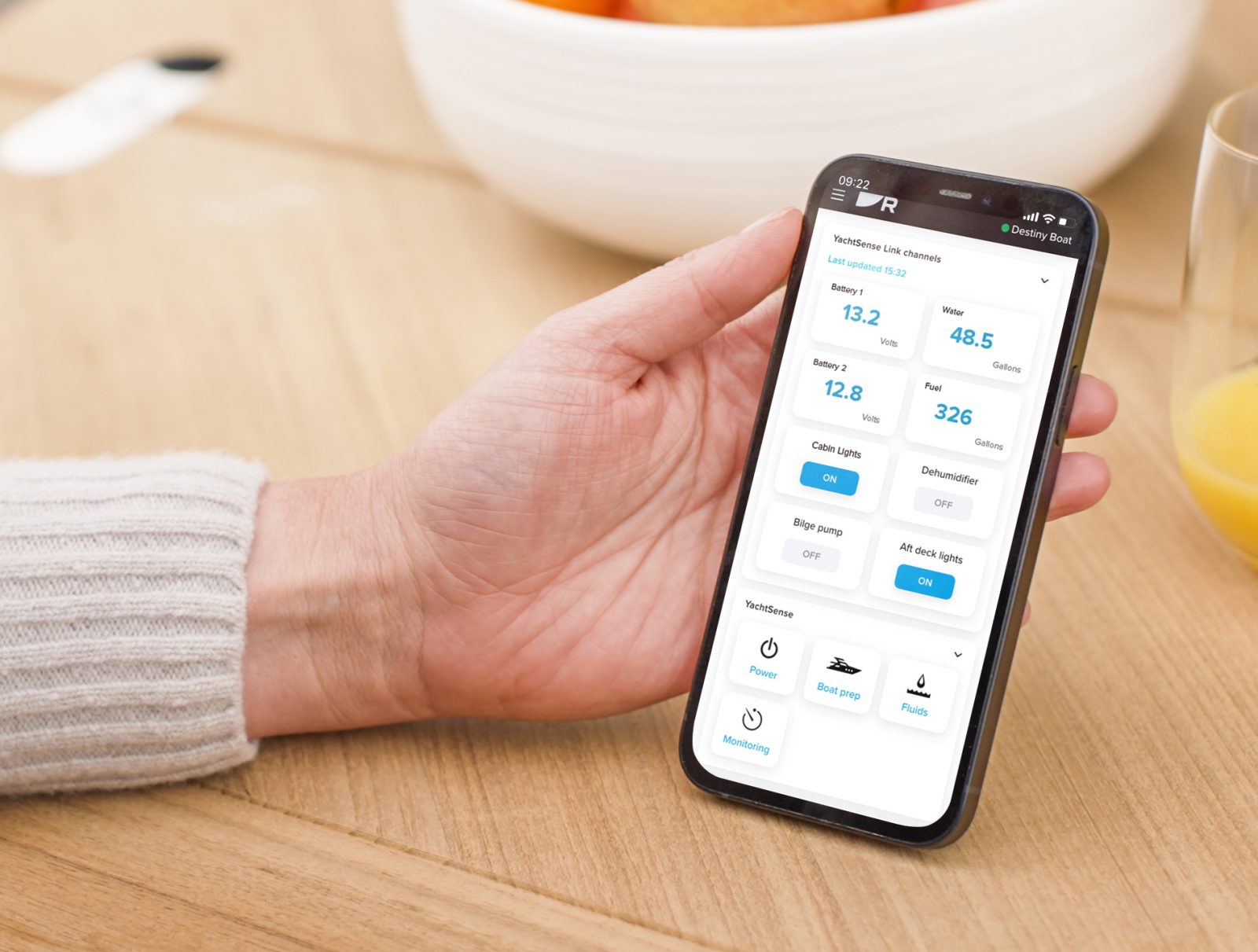Raymarine Unveils Remote Monitoring and Control Solution for Boats

New YachtSense Ecosystem Delivers a Smart Home Experience on the Water
Fareham, UK. February 16th, 2022-Today Raymarine unveiled its YachtSense Ecosystem, an onboard and remote monitoring solution that gives boaters effortless control of their Raymarine equipment and vessel systems from their mobile device. The YachtSense Ecosystem begins with the new Raymarine mobile app, a digital companion for Raymarine owners that provides simple onboard and off-boat integration capabilities. Enabling the YachtSense Ecosystem is the new YachtSense Link marine mobile router. YachtSense Link is an innovative device designed to keep boaters connected through 4G/LTE broadband, local Wi-Fi networks, and seamless integration with Raymarine devices. With the Raymarine app and YachtSense Link, boaters can remotely monitor critical onboard systems, control electrical devices, and sync with Raymarine navigation systems while underway.
The new Raymarinemobile app
The connected companion for Raymarine owners, the Raymarine app for iOS and Android devices, is the central point for integrating with the YachtSense Ecosystem and Axiom displays. The Raymarine mobile app allows boaters to easily onboard new devices, set up and modify their vessel profile, and backup and transfer waypoints and other data. With the Raymarine mobile app, boaters can also monitor instruments and NMEA2000 sensors, receive alerts, and view engine telemetry from their phone or tablet.
The Raymarine mobile app also transforms a mobile device into a full-function Axiom remote station, allowing users to stream and control Chartplotters from anywhere onboard. The Raymarine mobile app offers a Raymarine Premium subscription that allows boaters to monitor their boat from home and set up a high-resolution geofence around their boat. The Raymarine Premium geofence gives boaters peace of mind, allowing them to monitor the boat’s location remotely and receive alerts if the boat moves outside a defined geofence circle.

YachtSense Link Marine Router
YachtSense Link is a marinized marine mobile router equipped with Raynet Ethernet ports, mobile broadband connectivity, onboard Wi-Fi, and low-voltage digital switching/monitoring channels. YachtSense Link allows boaters to connect Raymarine Axiom displays, mobile devices, and other wireless devices like smart TVs to local marina Wi-Fi and create a unified, onboard Wi-Fi network. YachtSense Links keeps boaters always connected with 4G (LTE) connectivity. YachtSense Link supports dual SIM cards and allows seamless connectivity across two mobile networks when traveling internationally. Additionally, YachtSense Link integrates with the Raymarine mobile app to provide captains with complete access to their Raymarine network and equipment on any mobile device.

YachtSense Digital Control System
The YachtSense Ecosystem brings sophisticated smart home mobile connectivity to Raymarine’s award-winning YachtSense digital control system. With YachtSense Link and YachtSense Digital Control, boaters can remotely control and monitor multiple electrical devices. Activate bilge pumps, control lighting, monitor tanks, and fuel levels; it’s all possible with the Raymarine mobile app and YachtSense Ecosystem.
“Our YachtSense Ecosystem offers a connected boating solution for every boater,” says Gregoire Outters, VP and General Manager of Raymarine. “OurAxiom owners can take advantage of the new Raymarine app, and the YachtSense Link router will keep them connected with the security of remote vessel monitoring. And for our OEM boat builder partners, the YachtSense Ecosystem is a comprehensive and bespoke digital control solution offering new boat owners seamless onboard and off boat control and monitoring.”
The Raymarine mobile app is available as a free download from iOS and Google play store. The new YachtSense Link marine mobile router is available now for $1299.99USD / €1,295.00. For YachtSense Link users, a complimentary six-month trial of Raymarine Premium remote monitoring is available. After the trial period, Raymarine Premium subscriptions cost $19.99 per month, $110 for six months, or $200 annually. Learn more about YachtSense Ecosystem by visiting raymarine.com.
Panbo publishes select press releases as a service to readers and the marine electronics industry. The release contents do not reflect the opinion of the editors and are not fact checked by the editors













I think that the YachtSense Link router is one of the most interesting new major brand marine electronics products to come along in a while. Obviously it can do a lot of monitoring with its built-in GPS, NMEA 2000 connection, 4 digital switching channels, and — if the boat has it — a close relationship to YachtSense digital switching.
But less obvious in the press release is how it can provide a boat with a general use internet connection via cellular or onshore WiFi, even switch back and forth between the two automatically. And those are purportedly high-performance connections as the router comes with a 4-in-one outside antenna.
So there will soon be Raymarine equipped vessels with lots of connectivity for both monitoring and onboard use, but no third-party boat router, WiFi booster, cell router etc. Hasn’t Ray come up with a very appealing innovation?
Note that the new Raymarine app is not yet up for iOS or Android, but it seems to combine the abilities of the current RayControl and RayConnect apps, and will work directly with Axiom MFD WiFi. But it will also have the various monitoring abilities if connected to the Link router.
What the app apparently won’t do is enable route making on your mobile device with sync to the nav system. But Ray hinted that they will have solution for this in the future.
Also, I just noticed that the “dock” WiFi side of the Link router is dual band and the dual sim cell radio supports 2G, 3G, and 4G LTE, WCDMA, and GSM. Sounds good but I look forward to comments by Ben Stein who may get to see one in action today.
Interestingly, the Garmin GTB-10 OnDeck hub released a year ago has the majority of these features, control ability etc but does not allow Internet routing…
Hopefully Garmin see this and add the missing “In boat WiFi routing” functionality into their box?
Right, but I think that a major difference is that Garmin supplies the cell connectivity with their monitoring subscription while Raymarine does not. So while Garmin could probably allow OnDeck to do general internet connectivity, they’d either have to offer data plans or let the owner supply their own SIM card.
Ben Stein didn’t get into this in his OnDeck review but I’ll bet he’s asking about it:
https://panbo.com/garmin-ondeck-potential-aplenty-with-room-for-improvement/
If Ben Stein has the ear of a Garmin Tech rep in Miami here are a few “gaps” that would place the Ondeck functionaility well above Raymarine, Siren etc…
Configure the GTB-10 wifi router to work with AC and mobile devices directly while onboard, without the Garmin MFD powered ON (powersaving mode), AND without cellphone signal! Currently this does not work.
Configure Fusion airplay with GTB-10 wifi only, Garmin MFD switched off to save power. Currently the MFD needs to be on for Airplay to work which is crazy as the MFD does not provide the wifi AP.
Configure AC and the GTB-10 for low power useage “anchor drag” alerts with Garmin MFD OFF. , i.e position changes in the order of 50-100ft, not the current 304ft (100m) minimum for geolocation monitoring. Yes, the MFD can do this, but the GTB-10 and Iphone combo on wifi uses much less battery power and better alerting tech while sleeping etc.
Configure esim/Subscription to allow the Garmin Network created by the GTB-10 to route normal internet traffic to non garmin devices like phones etc. This would allow the GTB-10 to be the Boat Hub…
Definitely need the GTB-10 AP to work on wifi5 standards, not just wifi4, preferably wifi6…for all local and subnet devices on the boats network. Either that, or get with Peplink and allow a device like the new Pepwave Pro 5G with external antenas etc to be the primary AP/Router with the garmin equipment in client mode.
If Garmin implemented these fairly simple ideas, they would have the best boat comms/data hub/monitoring/remote control system by a long shot….
Thanks Ryan
I am a big fan of Raymarine, but as an Expert Network Engineer … so far, from what I can understand, this new router, is anything but new.
1) It doesn’t seem to have any option for wired WAN connection to upstream devices on the yacht, like a future starlink service or other service
2) The onboard wifi for the LAN is only 2.4Ghz … that is a huge problem with me, because if you know 2.4Ghz WIFI, there is only 3 usable channels. This is causing major issues in densely packed areas such a townhomes and apartment buildings where neighbors all interfere with each other in the 2.4Ghz range. Guess what, a busy marina is eventually going to have the same issues, if not already. Sure out on the hook, your wifi will be fine. But if you are using your Wifi on your phone or tablet for navigation as you come close to the marina, where you need it the most, it may loose connectivity.
3) Modern WIFI is now the 5GHz and even 6Ghz (in the latest 6Pe 802.11 standard), which gives many more channels, which solves the 2.4Ghz problem, and also higher bandwidth (which MIMO combines channels). At least the WAN side of this router it does look to support 5Ghz, but that does bring up the question, why doesn’t the LAN side?
4) Which leads me back to wired ethernet, it is always better than wireless for critical applications. Which is good that they have more wired RAYNET ports (but I believe they are 10/100, like the most on the RAYNET switch, vice 1Gig or even 2.5Gig+ ports which are already the norm and quickly becoming the norm, respectively, in modern networks. [A 5 or 8 port “dumb” Gig Ethernet switch cost $20 or $30.])
5) Time will tell what advanced features can be built into this router that might make it compelling still … whether some basic routing, port-forwarding, NAT/PAT, fire-walling, etc. … that will make it work better with IOT devices added to the Raymarine Ethernet network, or the boat wifi network. Without NAT and a good firewall, I would be concerned to put a RAYNET or NMEA2000 network online, and expose it to an IOT hacker.
6) I do commend Raymarine for supporting non-rarymarine IP cameras and other IOT connectivity (NETFLIX, etc.).
(My wish is to let the same cameras used for Augmented Reality to connect to a network attached storage device (NAS) for Network Video Recording (NVR) … Which would be possible if static routing was implemented from a RAYNET subnet to another subnet onboard without using the “master” MFD. This would allow for so many things, like recording docking, events, security cameras, etc..)
I was really hoping for Raymarine to create an incredible router, maybe version 2 might have some more of what I am looking for.
We are finishing an install for Raymarine on the boat so this is timely. Not sure if this is right for us or Siren. We like the Siren’s ability to semi-affordably work with Satellite to ping our InReach when we are off the boat exploring remote areas on foot/bike.
The puzzling thing here is Seatalk NG when the Axioms switched to normal N2K Devicenet Micro connectors. RayControl has a 2.4 star rating on the App Store.
It’s also hard to think of anything like this turning the boat into a smart home if it doesn’t work with HomeKit/Google Home/Alexa/Matter. Smart home is about automation, not just about being able to turn things on/off on my phone.
Speaking of phone apps – Raymarine needs to learn how to make one before I buy a piece of equipment that requires a phone to make it work.